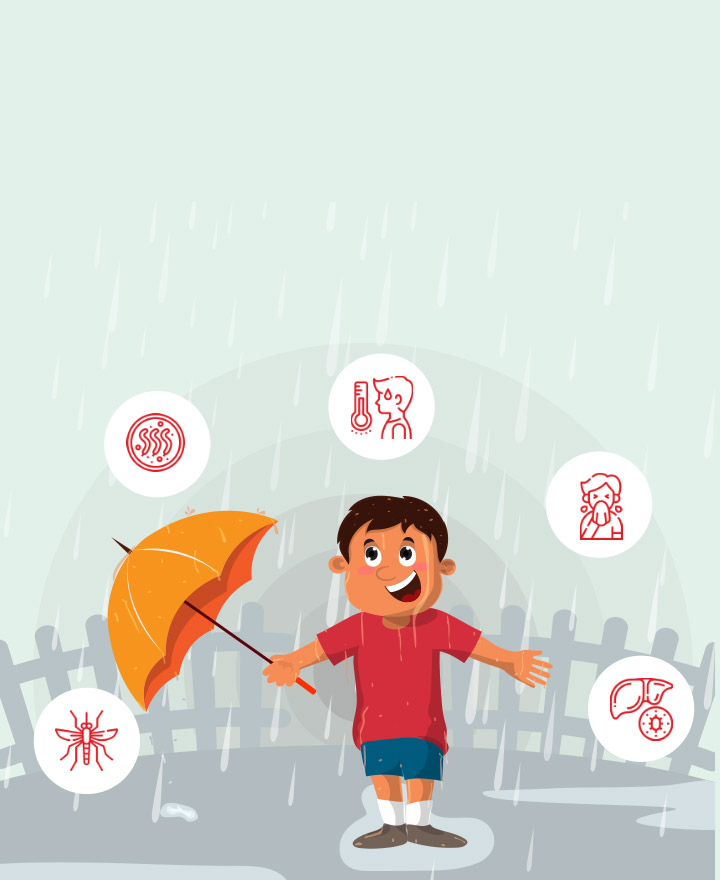

Link Between Rainfall and Cholera
Vibrio cholerae, the bacterium that causes cholera, thrives in rainy, damp weather, and its spread to communities is triggered by weather events like tropical storms, heavy rainfall, and flooding. Ingesting contaminated food and water leads to cholera. The dehydration caused by cholera can prove life-threatening without timely medical attention. Read on to know about the preventive measures we can adopt to suppress its spread and understand the correlation between cholera epidemics and the rains.
What is the Correlation?
The relationship between cholera and rainfall is significant. Cholera is often transmitted through contaminated water, and rainfall can impact this transmission in several ways:
1. Flooding:
Heavy rainfall can lead to flooding, which may contaminate drinking water sources with cholera bacteria from sewage or other waste. This increases the risk of outbreaks in affected areas.
2. Water Supply Contamination:
Rainfall can overwhelm water treatment systems, leading to the contamination of drinking water supplies with pathogens, including Vibrio cholerae, the bacterium that causes cholera.
3. Seasonal Patterns:
In many regions, cholera outbreaks are seasonal and correlate with the rainy season. For example, in parts of Africa and Asia, increased rainfall is often associated with higher incidences of cholera due to the reasons mentioned above.
Thus, managing water sanitation and public health interventions during and after heavy rainfall is crucial to preventing cholera outbreaks.
Physicochemical Condition in Monsoon
During the monsoon season, physicochemical conditions in water bodies can significantly impact the prevalence of cholera. Here are key factors linking these conditions to cholera outbreaks:
1. Water Temperature:
Warm temperatures, often associated with the monsoon season, can enhance the survival and growth of Vibrio cholerae in water. Higher temperatures can also increase the frequency of cholera outbreaks.
2. Water Contamination:
Monsoon rains can lead to runoff from agricultural fields, septic systems, and other sources, introducing pathogens into water sources. This contamination increases the likelihood of cholera transmission.
3. Turbidity:
Increased rainfall can cause higher turbidity (cloudiness) in water bodies. High turbidity can protect Vibrio cholerae from sunlight and other environmental stressors, potentially extending the bacteria's survival in water.
4. Nutrient Load:
Runoff can also introduce organic materials and nutrients into water sources, which can foster the growth of Vibrio cholerae and other bacteria.
5. tation Infrastructure:
The monsoon season can overwhelm sanitation systems, leading to the mixing of sewage with drinking water supplies. This can directly lead to cholera outbreaks if the water is consumed without adequate treatment.
Addressing these physicochemical factors by improving water and sanitation infrastructure and monitoring water quality during the monsoon can help mitigate the risk of cholera outbreaks.
Public Health Interventions
The interventions for suppressing a cholera outbreak include:
• Elimination of Source of Contamination
This includes identifying the contaminated food or water sources and cutting off supply completely.
• Improvement of Sanitation Infrastructure
This includes initiatives to improve sanitation through proper sewage disposal and water treatment.
• Strengthening and improving the water supply network
This includes steps taken by concerned authorities to supply clean drinking water to the population.
• Proper treatment facilities
This includes offering sick patients proper cholera disease treatment facilities, such as the timely administration of antibiotics and oral rehydration solutions to curb fatalities.
FAQs
1. How fast can a person die from cholera?
Dehydration is the actual cause of death from cholera. Severe dehydration due to diarrhoea and vomiting can actually kill a person within a few hours.
2. How does the contamination start?
The contamination starts when faecal matter containing the cholera bacterium enters food and water.
3. How to treat cholera?
Administration of oral rehydration solutions, antibiotics, zinc supplements, and intravenous fluids can treat cholera effectively.
4. Is there a home remedy for cholera?
The most effective home remedy for cholera is to prepare your own oral rehydration solution by adding salt and sugar to clean water. However, seeking medical treatment is crucial.
5. Why do cholera outbreaks increase during the rains?
Rainfall and flooding can contaminate water sources with sewage and faecal matter, leading to cholera outbreaks and the rapid spread of the disease.
Conclusion
The outbreak of cholera disease is indeed a critical challenge threatening public health. The disease is triggered by natural disasters and poor sanitation, hence the management plan should include proactive steps, especially in areas affected by waterlogging after the rains. Only through timely medical treatment and public health interventions can the spread of the disease be curbed.
One of the important components of our overall wellness is also being financially secured. Healthcare emergencies can happen any time, but a good health insurance policy can protect you from such uncertain situations. To know more about Wellness and other health related tips, visit the wellness corner.
Source: history.com, my.clevelandclinic.org, journals.asm.org, who.int
Disclaimer: This blog provides general information and discussions about health and related subjects. The information and other content provided in this blog, website or in any linked materials are not intended and should not be considered, or used as a substitute for, medical advice, diagnosis or treatment. Kindly contact your Doctor before starting a new medicine or health regime.
Related Articles
Exploring Cholera Outbreaks During The Rainy Season
Cholera Bacteria Survival Duration in Water
Waterborne Diseases - Causes, Symptoms & Prevention
List of Airborne Diseases to Watch Out for During Monsoon
Rainy Season Precautions - Health, Safety & Home Tips
Published on October 22, 2024














 Health Insurance
Health Insurance  Travel Insurance
Travel Insurance  Car Insurance
Car Insurance  Cyber Insurance
Cyber Insurance  Critical Illness Insurance
Critical Illness Insurance
 Pet Insurance
Pet Insurance
 Bike/Two Wheeler Insurance
Bike/Two Wheeler Insurance  Home Insurance
Home Insurance  Third Party Vehicle Ins.
Third Party Vehicle Ins.  Tractor Insurance
Tractor Insurance  Goods Carrying Vehicle Ins.
Goods Carrying Vehicle Ins.  Passenger Carrying Vehicle Ins.
Passenger Carrying Vehicle Ins.  Compulsory Personal Accident Insurance
Compulsory Personal Accident Insurance  Travel Insurance
Travel Insurance  Rural
Rural